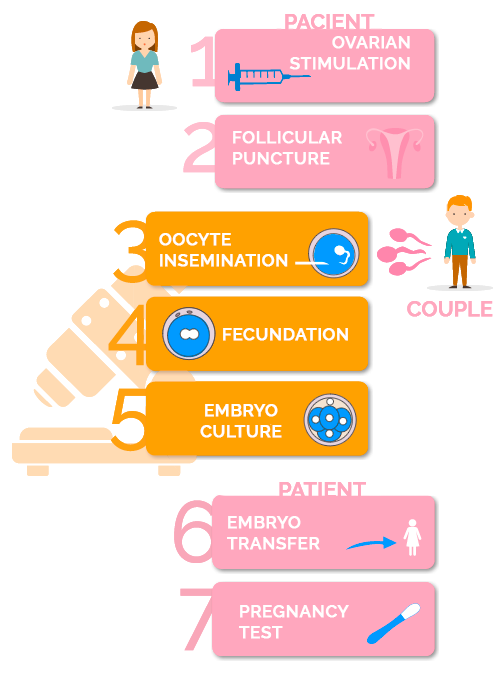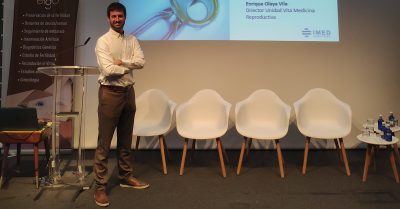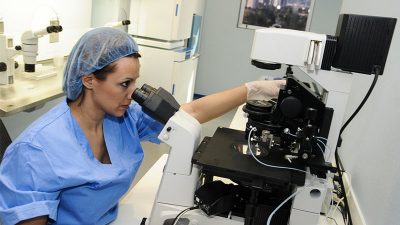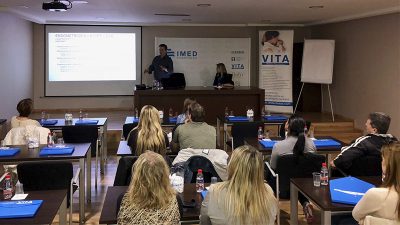In Vitro Fertilization with the couple’s semen

In vitro fertilization (IVF) with the couple’s semen is a technique by which the oocytes (immature eggs), once retrieved by follicular puncture, are fertilized in the laboratory by the couple’s sperm, with a semen sample able to optimize its fertilizing capacity. Those that are fertilized correctly are observed for several days until the moment when the best quality embryos are transferred to the maternal uterus. It is the most widely used assisted reproduction technique, achieving high pregnancy rates.
What is In Vitro Fertilisation (IVF) with the couple’s semen?
Treatment begins with ovarian stimulation. On the first day of your period you must call your patient assistant. They will inform you of the exact day to start the injections and the exact medication dose (following the gynecologist’s instructions). The ovaries are stimulated with gonadotropin hormones to develop the follicles and obtain more oocytes during that cycle.
Approximately 5 or 6 days after starting the medication, ultrasound scan controls will be performed to observe the growth of the follicles in the ovaries. These controls will be repeated every 48-72 hours until the follicles reach the appropriate size.
When the follicles have reached the appropriate size, the hCG (human Chorionic Gonadotropin) hormone is administered to trigger the final maturation of the oocytes. When it is considered that there is a sufficient number of oocytes, follicular puncture is performed.
In order to retrieve the oocytes, in the operating room their liquid will be aspirated using a very fine needle under transvaginal ultrasound guidance. It is a minimally invasive and fast intervention. The patient will be sedated for approximately 10-15 minutes, and will be able to return to her activity immediately.
Once the oocytes are obtained, the couple’s sperm will be prepared, which is known as sperm capacitation.
The couple’s semen sample is selected in the laboratory using washing techniques, where the sperm with the highest mobility will be selected.
The VITA biomedical team will decide, based on the history and characteristics of the patient, which insemination technique (IVF or ICSI) is the most appropriate.
Through conventional IVF, the retrieved oocytes and the capacitated spermatozoa are brought into contact in a laboratory dish, and one of them is expected to fertilize the oocyte autonomously.
Through ICSI (intracytoplasmic sperm injection), in the laboratory the embryologist directly introduces a selected spermatozoon from the semen sample into each oocyte with the help of a micromanipulator and a microneedle.
The day after the insemination, the fertilization of the oocytes is monitored. Those that have been correctly fertilized will be kept in the laboratory under observation for several days (between 2 and 5 days).
Day by day you will see how the embryos are dividing and their number of cells is increasing.
The resulting embryos with the appropriate morphological characteristics will be the ones transferred to the maternal uterus. The surplus of embryos will be cryopreserved.
The gynecologist will use a small catheter to guide the embryos through the cervix and into the uterus. The embryo transfer procedure lasts a few minutes and patient recovery time is minimal.
To facilitate embryo implantation, progesterone is administered into the vagina to support the luteal phase.
The pregnancy test will be carried out by means of a blood test 13 days after the follicular puncture.
If the patient suffers from bleeding or spotting before the test is performed, it is important that she never stops taking the medication and that she contacts the medical team for advice.
Throughout the in vitro fertilization treatment, her personal assistant will be available at all times to answer any questions she may have and support her in this very special moment.

For whom is this technique indicated?
In Vitro Fertilisation with the partner’s semen ( IVF equivalent) is indicated for:
- Couples where the woman has obstructed or absent fallopian tubes.
- Couples where the woman has moderate or severe endometriosis.
- Couples where the woman has ovulatory problems.
- Couples where the woman is elderly.
- Couples where the man has mild-moderate alterations in seminal parameters (moderately decreased sperm count and/or motility).
- Couples that have failed previous Artificial Inseminations.
- Couples with unexplained infertility
The requirements for a couple to undergo in vitro fertilization and have the best chance of success are:
- The semen sample must present adequate count and motility parameters.
- The use of an ultrasound scan to rule out possible uterine malformations that could affect the implantation and development of the pregnancy. In addition, to guarantee a response to ovarian stimulation in order to retrieve a minimum of suitable oocytes for the performance of the technique.





